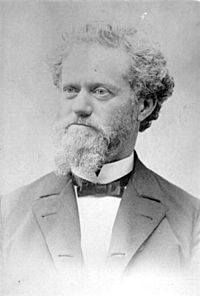Andrew Smith Hallidie facts for kids
Quick facts for kids
Andrew Smith Hallidie
|
|
|---|---|
 |
|
| Born | March 16, 1836 |
| Died | April 24, 1900 (aged 64) |
| Occupation | promoter of the Clay Street Hill Railroad |
| Known for | Inventing the cable car and father of the present day San Francisco cable car system |
Andrew Smith Hallidie (born March 16, 1836 – died April 24, 1900) was an important inventor. He helped create the world's first practical cable car system. This system was built in San Francisco, USA. Many people see him as the inventor of the cable car. He also brought the making of wire rope to California. When he was young, he built many bridges in California.
Contents
Andrew Smith Hallidie's Early Life
Andrew Smith Hallidie was born Andrew Smith. He later changed his last name to Hallidie. He did this to honor his uncle, Sir Andrew Hallidie. Andrew was born in London, United Kingdom. His mother was Julia Johnstone Smith. His father, Andrew Smith, was also an inventor. His father invented the first box door spring. He also had an early patent for wire rope.
When Andrew was 13, he started working. He learned about machines and drawing. In 1852, at age 16, he sailed to California with his father. His father was interested in some gold mines. These mines did not do well. His father went back to England in 1853. Andrew stayed in California. He became a gold miner. He also worked as a blacksmith, a surveyor, and a bridge builder.
In 1856, Andrew was building a water channel at a mine. He noticed that the ropes used to lower rock cars wore out very fast. They lasted only 75 days. Andrew made a new wire rope using his father's design. This new rope lasted two years. This is how he started making wire rope in California.
Wire Rope and Bridges
In 1857, Hallidie stopped mining. He moved back to San Francisco. He started a company called A. S. Hallidie & Co.. His company made wire rope. They used the same machines he had used at the mine.
Hallidie also built many bridges. From 1861 to 1862, he built bridges across several rivers. These included the Klamath River and the American River. In 1863, he built a bridge in British Columbia.
Also in 1863, Hallidie married Martha Elizabeth Woods. They did not have any children. In 1864, he became a United States citizen. By 1865, he stopped building bridges. He focused only on his wire rope business. There was a high demand for wire rope from the silver mines.
In 1867, Hallidie invented the Hallidie ropeway. This was a type of aerial tramway. It was used to carry ore and other materials across mountains. He installed these systems in many places. He later got a patent for his invention.
The Famous Cable Cars
There are different stories about how Hallidie got involved with the Clay Street Hill Railway. One story says he took over the project. The first person trying to build it could not get enough money. Another story says Hallidie started the idea himself. He wanted to help the horses. These horses had to pull streetcars up very steep hills.
It is also unclear exactly when the first cable car ride happened. The company needed to have the first ride by August 1, 1873. Some say it happened a day late, on August 2. But the city did not cancel their plan. Some stories say the first driver was scared. He looked down the steep hill and would not drive the car. So, Hallidie drove the car himself. He drove it down the hill and back up without any problems.
The engineer for the Clay Street line was William Eppelsheimer. But Hallidie knew a lot about cables. He had worked with cable systems before. So, it is likely he helped design the cable car system.
The Clay Street line started regular service on September 1, 1873. It was a big success. Hallidie's patents for the cable car design were used all over the world. This made him a very rich man.
Other Important Activities
Hallidie was active in San Francisco. He was a leader at the University of California. He was also a trustee and president of the San Francisco Mechanics Institute. In 1873, he ran for the California State Senate. In 1875, he ran for mayor of San Francisco. He did not win either election.
Hallidie was a trustee for the First Unitarian Church. He was also a member of many groups. These included the American Society of Inventors and the California Academy of Sciences. He was also part of clubs like the Pacific-Union and Sierra clubs.
His company, A. S. Hallidie & Co., became the California Wire Works in 1883. Hallidie was the president. In 1895, the company was sold.
Andrew Smith Hallidie died on April 24, 1900. He was 64 years old. He died from heart disease at his home in San Francisco.
In San Francisco, there is a place called Hallidie Plaza. It is near the cable car turntable. The Hallidie Building is also named after him. These places honor his memory.
See also
 In Spanish: Andrew Smith Hallidie para niños
In Spanish: Andrew Smith Hallidie para niños


